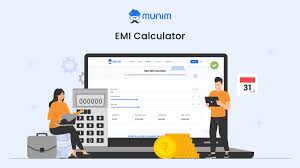Understanding the EMI Structure with a Business Loan EMI Calculator

Business loans are crucial for startups, MSMEs, sole proprietorships and even self-employed professionals. No matter what kind of business organisation your venture has, it is crucial to understand your loan thoroughly before you commit to it. Otherwise, you run the risk of overborrowing and potentially defaulting on payments. This, in turn, could reduce your credit score and lead to several negative outcomes for your business.
So, one of the most important aspects of your loan that you must be aware of is the EMI amount. That said, it is not enough to merely know what the EMI amount is. It is also essential to understand how it is structured and how different factors like loan tenure and loan interest rate can impact the EMI.
Let us delve into these aspects to understand how the EMIs in your business loan are structured.
What is a Business Loan EMI?
A business loan EMI (equated monthly instalment) is a fixed payment that the borrowing business makes each month to the lender. Each EMI is a crucial step in repaying business loans. It consists of the principal (which is the amount borrowed) and the interest. This structure allows you to repay the loan systematically over the chosen loan tenure.
The amount to be repaid via EMIs each month depends on factors like the loan interest rate, the repayment tenure and the repayment structure. You can use a business or MSME loan EMI calculator to estimate your monthly repayment obligation and plan your finances accordingly. These calculators use a standard EMI calculation formula, which factors in the principal, interest rate and repayment period.
Breaking Down a Business Loan EMI: Principal and Interest Components
Every EMI amount in a business loan consists of two key components — the principal and the interest. You must understand how these two elements interact with one another, so you can manage your business loan repayments more effectively. It also helps you obtain clarity about the output from financial tools like MSME loan EMI calculators.
Let’s decide what each component in the EMI amount entails.
- Principal Component:
The principal component is that portion of the EMI that goes towards repaying the original amount borrowed via a business loan. In the early stages of repayment, only a small part of the EMI covers the principal. A large share goes towards repaying the interest. Over time, as the outstanding balance reduces, the principal component in the EMI amount increases.
- Interest Component:
Interest is the cost of borrowing money via a business loan. It is calculated on the amount of loan balance that is still outstanding. Since the principal to be repaid is still high in the initial months of repayment, the interest component is correspondingly higher. As the loan repayments progress and the principal due reduces the interest portion of the EMI also decreases.
What is a Business Loan EMI Calculator?
A business loan EMI calculator is a financial tool that is available online. It helps you calculate your monthly loan repayments. You can quickly determine your business loan EMI by providing some key details like the loan amount, loan tenure and interest rate. This saves you the trouble of manual calculations.
With a business loan EMI calculator, you get a clear breakdown of how much your business needs to pay each month. This makes financial planning and budgeting easier. This financial tool uses the EMI calculation formula to find the exact repayment amount after factoring in the inputs. You can also understand how the interest and principal components make up the structure of each EMI.
It is especially useful for MSMEs and startups that are interested in evaluating different loan options before borrowing money. By using an MSME loan EMI calculator, businesses can compare loan offers, weigh different repayment scenarios and choose suitable loans that are easy to manage and repay.
EMI Calculation Formula
For term loans that businesses avail of, the EMI calculation formula only requires the principal amount, the monthly rate of interest and the loan tenure. If you have these details, you can compute the EMI amount using this formula:
EMI = [P x r x (1 + r)n] ÷ (1 + r)n — 1
Here is what the letters in the formula stand for:
- P is the principal amount borrowed
- r is the rate of interest per month
- n is the loan tenure expressed in months
With these details, you can compute the EMI easily. However, a loan EMI calculator may be a better choice because it offers instant results and helps you avoid the issue of manual computational errors. What’s more, many calculators today also help you understand the EMI structure better by offering deeper insights in the form of a loan amortisation schedule.
How a Business Loan EMI Calculator Helps You Understand the EMI Structure
A business loan EMI calculator simplifies loan repayment because it breaks down each monthly instalment into its interest and principal components. So, businesses borrowing funds can visualise how their repayments will be structured over time. This, in turn, makes it easier to plan finances and approve budgets.
Here’s a closer look at how a business loan EMI calculator can help you understand the structure of your business loan EMIs.
- Clarity About Principal and Interest
One of the biggest advantages of using this calculator is understanding how each EMI payment is split between interest and principal amounts. Initially, the interest dominates the EMI amount, while the principal component increases with time. While the EMI calculation formula does not offer this breakup, business loan EMI calculators give you this crucial insight.
- The Impact of Loan Tenure on EMIs
A business loan EMI calculator also helps you understand how changes in the loan tenure can affect your monthly repayments. A longer loan tenure lowers the amount of each EMI but increases the interest payable overall. However, a shorter loan tenure means you’ll have to pay higher EMIs but reduces the total interest payable over the repayment duration.
- Comparison of Different Scenarios
By adjusting the inputs like the loan duration, loan amount and interest rate, businesspersons can compare how the EMIs and their structures change. This makes it easier to evaluate multiple scenarios and select the best parameters for a business loan. It can be particularly useful for businesses that seek optimal funding solutions that come with manageable EMIs.
Factors That Influence EMI Calculation
Several factors affect the EMI amount for a business loan. This determines how much a business has to set aside each month to meet the cost of borrowing. A business loan EMI calculator considers all these factors and provides accurate EMI estimates, so companies and other ventures can make informed financial decisions.
Here are some key elements that affect the EMI amount.
- Loan Amount
The loan amount is the total sum borrowed from the lender, and it directly affects the EMI. A higher loan amount leads to larger monthly payments, while a smaller loan results in lower EMIs. Businesses should assess their financial needs carefully to borrow an amount they can comfortably repay without straining the cash flow.
- Loan Tenure
The loan tenure or repayment period determines how the duration a business has to repay the loan. A longer tenure increases the total interest paid but reduces the EMI. On the other hand, a shorter tenure results in higher EMIs but lower overall interest costs. Using a business loan EMI calculator helps borrowers choose the ideal tenure based on their affordability.
- Interest Rate
The loan amount interest rate set by the lender significantly impacts EMI calculations. Higher interest rates lead to increased EMI payments and raise the overall cost of borrowing. A lower rate, however, reduces monthly instalments and makes repayment more manageable. Businesses should compare different lenders and loan offers to secure the most favourable rate.
- Type of Interest Rate
Business loans may have fixed or floating interest rates, both of which impact the EMI structure. Fixed rates keep the EMI amount constant throughout the tenure and offer predictability. Floating rates fluctuate based on market conditions, meaning the structure of EMIs may change over time. Businesses should evaluate which option aligns best with their financial planning and risk tolerance.
Amortisation Schedule: How Does the EMI Change Over Time?
An amortisation schedule is a detailed table that shows how a business loan is repaid over time. It involves breaking down each EMI into principal and interest components. While the EMI amount remains constant in most business loans, the proportion of principal and interest changes throughout the tenure. Initially, a larger part of the EMI is allocated to the interest, but as the loan progresses, the principal repayment increases.
Many business loan calculators offer a detailed breakup of the EMI structure on a monthly or annual basis. Let us discuss an example to better understand what an amortisation schedule from these calculators entails.
Say you run a small business and require a loan of ₹5,00,000 to fund business growth. You apply for a loan from your banking partner and obtain the financing at an interest rate of 15% per annum. The amount borrowed is repayable over five years. If you enter these details in an MSME loan EMI calculator, you will find that the EMI amount comes out to approximately ₹11,895 per month or ₹1,42,740 per year.
You can also find the EMI structure in the annual amortisation schedule, as given below:
| Year | Opening Balance (₹) | Interest Repaid (A) (₹) | Principal Repaid (B) (₹) | Total EMI (A + B) (₹) | Closing Balance (₹) |
| 1 | 5,00,000 | 70,143 | 72,596 | 1,42,740 | 4,27,404 |
| 2 | 4,27,404 | 58,473 | 84,266 | 1,42,740 | 3,43,137 |
| 3 | 3,43,137 | 44,927 | 97,813 | 1,42,740 | 2,45,325 |
| 4 | 2,45,325 | 29,203 | 1,13,537 | 1,42,740 | 1,31,788 |
| 5 | 1,31,788 | 10,952 | 1,31,788 | 1,42,740 | 0 |
As you can see, the total EMI amount remains the same, but its components change. Let us further discuss how the EMI changes over time:
- High Interest, Low Principal in the Early Phase
At the beginning of the loan tenure, a significant portion of the EMI covers the interest (charged at the loan amount interest rate). Only a small part reduces the principal. This is because the interest is calculated on the outstanding loan balance, which is at its highest when the repayment tenure begins. You must account for this when planning the early-stage cash flows of your business.
- Gradual Shift Towards Principal Repayment
As you continue to pay the EMIs on your business loan, the outstanding loan balance decreases. This, in turn, reduces the interest component. Gradually, a larger share of the EMI goes toward repaying the principal instead. A business loan EMI calculator can help you visualise this shift and allow you to see how the repayment structure evolves over time.
- Faster Repayment with Prepayments
Making extra payments toward the loan can accelerate the rate at which the principal is repaid. This eventually leads to lower interest payments over the entire loan tenure. Some lenders allow prepayments without penalties, so businesses save on the total cost of borrowing. By checking the amortisation schedule using an MSME loan EMI calculator, you can determine the impact of early repayments.
Fixed vs. Floating Interest Rates: And Their Impact on the EMI Structure
The type of interest rate on a business loan significantly affects how the EMI amount changes over time. Fixed and floating interest rates have different implications for borrowers, as shown in the table below:
| Particulars | Fixed Interest Rate | Floating Interest Rate |
| EMI Amount | Remains constant | Varies based on market rates |
| Interest Rate Stability | Predictable and fixed | Fluctuates with market conditions |
| Risk | Low risk as the EMI is stable | Higher risk as the EMI can increase |
| Total Interest Paid | Usually higher because of its fixed nature | Can be lower if the rates decrease |
| Suitable For | Businesses that prefer stability | Businesses willing to take market risks |
With a fixed interest rate, the monthly instalment amount obtained from the EMI calculation formula remains constant throughout the loan tenure. This allows you to plan your business finances effectively because you know exactly how much you need to pay each month. However, fixed rates are generally higher than floating rates. This may lead to higher total interest costs.
Floating rates, on the other hand, fluctuate based on market conditions. This means that the EMI amount may rise or fall during the loan tenure. While your business may benefit from lower EMI payments when the rates drop, it also risks higher EMIs if the rates increase.
How to Use an EMI Calculator to Plan Loan Repayments Efficiently?
A business loan EMI calculator helps businesses structure their loan repayments effectively — ensuring better financial planning and cash flow management. Here’s how you can use it efficiently for your venture:
- Estimate the Monthly Obligations
By entering the loan amount, interest rate and tenure, you can quickly determine the monthly EMI for your business loan. This helps you prepare a suitable budget and ensures that the loan repayments do not strain the operational expenses of your business.
- Compare Different Loan Scenarios
Using the EMI calculation formula, businesses can compare different loan options, adjust the tenure and interest rates and find the most affordable repayment plan. This helps in selecting a loan structure that balances EMI affordability with long-term interest savings.
- Plan for Prepayments and Loan Tenure Adjustments
The calculator helps businesses analyse how making extra payments or choosing a shorter loan tenure affects overall interest costs. Prepaying a portion of the loan reduces the outstanding balance faster, leading to significant interest savings and early loan closure.
Conclusion
Ultimately, a business loan EMI calculator isn’t just a tool. It can offer you a financial roadmap to understand your business loan EMI amount better. It breaks down your EMI amount, so you can compare different loan options and plan your repayments smartly. So, if you want to obtain a business loan or if you are already repaying one, you can always use an MSME business loan calculator to understand the EMI structure and make informed decisions.





